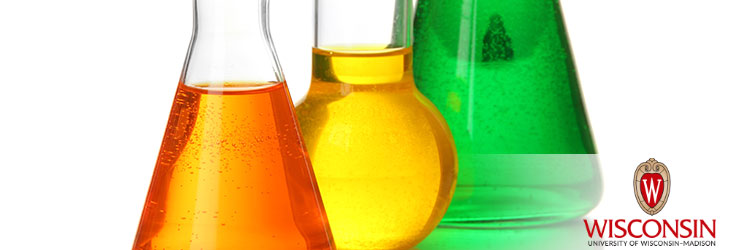Materials & Chemicals

More Efficient Production of Polymer Chemical from Biomass Glucose
WARF: P120054US01
Inventors: James Dumesic, Yomaira Pagan-Torres, Brent Shanks, Tianfu Wang
The Wisconsin Alumni Research Foundation (WARF) is seeking commercial partners interested in developing a cost-effective method of deriving the platform chemical 5-hydroxymethylfurfural from glucose by utilizing Lewis acid and Brønsted-Lowry acid catalysts.
Overview
Beyond its fuel potential, biomass is poised to supplant nonrenewable sources in the production of important building block chemicals. One such intermediary is 5-hydroxymethylfurfural (HMF), a primary component used to make plastic materials analogous to those derived from the petroleum polymer industry.
Efforts to render HMF from biomass traditionally have focused on dehydrating fructose in high yields using ionic liquids, which are expensive, susceptible to impurities and difficult to separate from the product stream. Glucose, another renewably derived carbohydrate, contains only one-twentieth of the appropriate tautomers in solution and because of low yield has remained an underutilized resource.
A new approach is needed that exploits glucose and glucose-containing saccharides and polymers at yields comparable to fructose, without the drawbacks of ionic acids.
Efforts to render HMF from biomass traditionally have focused on dehydrating fructose in high yields using ionic liquids, which are expensive, susceptible to impurities and difficult to separate from the product stream. Glucose, another renewably derived carbohydrate, contains only one-twentieth of the appropriate tautomers in solution and because of low yield has remained an underutilized resource.
A new approach is needed that exploits glucose and glucose-containing saccharides and polymers at yields comparable to fructose, without the drawbacks of ionic acids.
The Invention
UW–Madison researchers have developed a method to produce HMF from biomass-derived glucose in a two-phase reaction system using Lewis acid and Brønsted-Lowry acid catalysts.
Conducted in a two-phase reaction vessel, the method isomerizes the glucose feedstock material, chemically transforming it into fructose while simultaneously converting that fructose via dehydration into HMF. The aqueous component of the medium comprises the glucose and both types of homogenous acid catalysts. The solution may be saturated with sodium chloride. The organic extraction layer preferably contains one alkylphenol, and into this layer the HMF spontaneously separates.
The two sugar reactions—isomerization and dehydration into HMF—occur in tandem, result in high yields, increase separation efficiency and react in a system that can be conducted continuously or in batch fashion.
Conducted in a two-phase reaction vessel, the method isomerizes the glucose feedstock material, chemically transforming it into fructose while simultaneously converting that fructose via dehydration into HMF. The aqueous component of the medium comprises the glucose and both types of homogenous acid catalysts. The solution may be saturated with sodium chloride. The organic extraction layer preferably contains one alkylphenol, and into this layer the HMF spontaneously separates.
The two sugar reactions—isomerization and dehydration into HMF—occur in tandem, result in high yields, increase separation efficiency and react in a system that can be conducted continuously or in batch fashion.
Applications
- Production of furanic polyesters, polyamides and polyurethanes that can be used in the manufacture of plastics from renewable resources
Key Benefits
- Combined, efficient reaction
- High yield from glucose
- No use of ionic liquids
- Amenable to one- or two-phase reaction method
Stage of Development
The researchers have shown HMF yields of 67 percent.
Additional Information
Related Technologies
Tech Fields
For current licensing status, please contact Mark Staudt at [javascript protected email address] or 608-960-9845